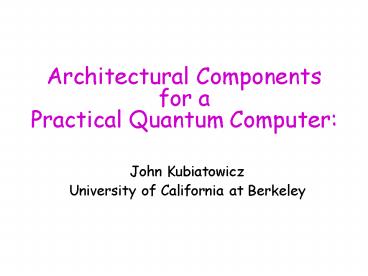Architectural Components for a Practical Quantum Computer: PowerPoint PPT Presentation
1 / 18
Title: Architectural Components for a Practical Quantum Computer:
1
Architectural Components for a Practical
Quantum Computer
- John Kubiatowicz
- University of California at Berkeley
2
QARC The Quantum Architecture Research Center
- Four Researchers
- Fred Chong (UC Davis)
- Isaac Chuang (MIT)
- Mark Oskin (U Washington)
- John Kubiatowicz (UC Berkeley)
- Funny quote on someones web site
- Perhaps appropriately, given the uncertainty
principle that underpins quantum mechanics, this
center does not have a specific physical
location, but is rather a community of several
research labs led by Fred Chong, Isaac Chuang,
and John Kubiatowicz.
3
What does an architect (i.e. me) Think about?
- Big systems
- Millions or Billions of interacting elements
- Not 7-10 bits
- Buildable systems
- Constructed from smaller, easily composed
elements - Possible to verify functionality
- Over 50 of modern design teams for verification
- Verifying a quantum bit -- harder than
asynchronous logic??? - Easy to fabricate
- Programmable systems
- Can be directed to do some desired task
- Easy use of abstraction, high-level languages,
compilers - Could use automated programming techniques, but
still need some human-specified goal set - Can be debugged
4
Does this have any relevance to Quantum Computing?
- Big/Scalable?
- Has to be something with easily repeatable units
- Given current sophistication of fab technology
- This probably means silicon-based?
- Buildable?
- Components that we understand means
- That are bigger than a bit!
- It also means that we can multiplex/reuse pieces
- Possibly with CAD tools?
- Programmable?
- Yeah, well
5
Classical Computer Components
- Von Neumann architecture has
- Memory, CPU, Registers, I/O
- Very powerful abstraction/good building blocks
- Physical Extent of components (say on 2-d chip)
- Means that we need WIRES
- Ground/VDD?
- Nice source of 0 and 1
- Signal preservation through coding
- In principle could put ECC everywhere
- Extensive design flow
- CAD tools for producing circuits/laying them
out/fabricating them, etc.
6
Start with Scalable Technology
- Big interest in Kane proposal, for instance
- Others certainly possible (No offense intended!)
7
Interesting problemClassical Interface to
Quantum Domain?
5nm access points contain only a handful of
quantum statesat temp lt 1K
8
Perhaps a solution?
As two physical dimensions ofthe access point
exceed 100nmthousands of electron states are
held.
Classically, thesestates are restrictedto the
access point,however, quantummechanically
theytunnel downward,guided by the via,thus
enabling control.
9
Pitch-matching nightmare??
Classical access points
100nm
100nm
100nm
100nm
5nm
Narrow tipped control
20nm
20nm
10
Example of ComponentsThe Entropy Exchange Unit
Vazirani-Schulman sorting across boundary
!
Garbage In
Cooling
11
Why is this important?
- Initialized states (zeros, for instance) required
for - Initialization of Computation (not surprising)
- Error correction (continuous consumption)
- Long-distance quantum transport (wires)
- Entropy exchange probably needed everywhere!
12
What is involved here?
- Substrate capable of quantum computation
- Possibilities for cooling
- Spin-polarized photons ?spin-polarized electrons
?spin-polarized nucleons - Simple thermal cooling of some sort
- Two material domains
- One material in contact with environment
- One material isolated
- Quantum computing across boundary
- Ack! Most basic operation requires some computing
13
What about wires?A short quantum wire
- Key difference from classical
- quantum information must be protected/restored!!
- Cannot copy information (no fanout)
- Cannot (really) amplify this info
- Short wire constructed from swap gates
- Each step requires 3 quantum-NOT ops (swap)
14
Why short wires are short
- Limited by decoherence
- Threshold theorem gt distance
- For some assumptions ? 1.8mm (very rough)
- Very coarse bounds so far
- Can make longer with repeater?
- Essentially this is multiple short
wiresSeparated by error correction blocks
15
How to get longer wires??
- Use Quantum Teleportation
- Transfers EPR pairs to either end of wire
- Measures state at source, transfers bits to dest
- Source bit destroyed at source, reconstructed at
dest - Key insight
- EPR pairs are known states
- No need to protect them
- Purify the good ones
- Discard the bad
16
Architecture of a long wire
Quantum EPR channel
EPR Generator
Teleporation Unit
Teleporation Unit
Classical control channel
EPR channel
Purification
Coded Tele- Portation
Entropy Exchange
17
Long wires
- COMPLEX!!! Much computation at either end
- Need to purify EPR pairs
- Need to measure
- Can be of arbitrary length
- A 10mm wire sustains nearly peak bandwidth
- Latency matches classical latency
- Pre-communicate EPR pairs/pipeline purification
- Latency is constant teleportation operation
- Code-conversation for free
- Facilitates Processor lt-gt Memory
communicationCOC02
18
Conclusion
- Perhaps not too early for Architects to start
thinking about quantum computing - Important non-classical components
- Entropy exchange units/EPR generators
- Wires Multiple varieties
- Other things (I didnt even bother to talk
about) - Memory/CPUs, etc
- CAD tools
- Etc.
- Will we ever really have to worry about 1000s or
millions of bits? - Hopefully

